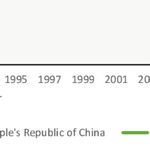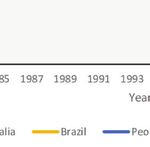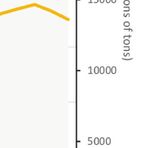Policy brief for Australia - The Lancet Countdown on Health and Climate Change
←
→
Page content transcription
If your browser does not render page correctly, please read the page content below
Introduction
Climate change is a substantial and mounting threat to public health in Australia. Extreme weather events, rising temperatures and altered
infectious disease patterns are among many climate-related hazards to the health and wellbeing of Australians.1 The Australian Medical
Association recently declared climate change a ‘health emergency, with clear scientific evidence indicating severe impacts for patients and
communities now and in the future.’2 There is an urgent need to develop and act on ambitious national climate change and human health
policies.3 These risks demand a thorough and decisive response at all levels of Australian government. Policy interventions can minimise the
impacts of climate change on health and wellbeing.4 Developed in consultation with Australian experts in climate change and health, this
briefing provides evidence-based recommendations for Australian policymakers, based on the 2019 MJA-Lancet Countdown Australia
report3 and the global Lancet Countdown report.5
Key messages and recommendations
With updated nationally determined contributions (NDCs), which are country targets of reductions in greenhouse gas emissions under
the United Nations Framework Convention on Climate Change, due by 2020, Australia should integrate health considerations throughout
proposed interventions for both mitigation and adaptation, with particular consideration to policies concerning energy, heat and health
systems.
Expedite a transition from fossil fuels to zero emission renewable energy
1 across all economic sectors, with support to affected communities.
Develop a national climate change and health strategy. This strategy
2 should build on the framework developed by the health sector to
coordinate action on mitigation and adaptation at all levels of
Australian government.4
Advance comprehensive and multi-sectoral heat hazard reduction
3 strategies to minimise heat exposure and sensitivity across Australia.
Pay particular attention to the needs of vulnerable populations.Expedite a transition to renewables
Australia continues to depend on fossil fuels (mainly coal and natural
BOX 1: HEALTH IMPACTS OF COAL
gas) for domestic energy generation and as a trade export. This presents a
threat to the health of current and future generations (see Box 1) . A Coal harms public health in Australia by emitting toxic substances into
systematic, expeditious transition to renewable energy production will land, air and water.
prevent death, disease and disability, with associated economic These pollutants cause significant cardiovascular and respiratory morbid-
savings. It is equally important that proactive measures are taken to ity and mortality, with coal harming human health at each phase of its
support affected communities to protect them from the health impacts production, transport and combustion.6
of lost employment. The health impacts of coal in Australia have been estimated at around
$2.6 billion each year.7
Australia is the world’s largest net exporter of coal and liquefied
natural gas. Domestically, the vast majority (91%) of coal
sources.3 However, 60% of Australia’s total electricity generation
consumption goes towards power generation,8 with Australia’s
was from coal in 2018.3 Renewable and low carbon energy
energy system remaining highly carbon intensive (Figure 1).
production in Australia is far lower than comparable developed
The 2019 MJA-Lancet Countdown report documents encouraging countries such as the UK and Germany.5 From 2014 to 2017, the
progress in terms of zero- and low-carbon energy production in contribution of coal to electricity generation in the UK decreased
2018, with 21% of Australia’s energy provided by renewable energy from 30% to less than 7%.5
Figure 1: Carbon intensity of total primary energy supply for Australia, selected countries, and the world, and corresponding
total carbon dioxide (CO2) emissions, 1971-2016.3National planning for climate and health
Adaptation and mitigation strategies can complement each other to climate change and health mitigation and adaptation
significantly reduce health risks and consequences from climate plan for Australia, although a framework for a national
change. Crucial adaptive measures, such as workforce capacity- strategy has been developed by Climate and Health Alliance in
building, housing policies, and urban planning, will require significant consultation with healthcare stakeholders.4 Queensland
long-term planning and investment. Proactive, health-specific climate remains the only state with a comprehensive, specific
adaptation planning by all levels of Australian government is therefore climate change and health adaptation plan (see Box 2).9
critical, and will present opportunities to achieve significant health and Encouragingly, Tasmania is in the process of producing a health
economic co-benefits. adaptation strategy, and Western Australia is conducting a
climate change and health inquiry, due to report in early 2020.
Globally, the number of countries preparing for the health risks of The scale and complexity of public health challenges posed by
climate change has increased, with 51 countries reporting having a climate change necessitate leadership, coordination and
national health and climate change plan.5 There is no national resourcing at a Federal level.
BOX 2: HUMAN HEALTH AND WELLBEING CLIMATE CHANGE ADAPTATION PLAN FOR QUEENSLAND (H-CAP)
The H-CAP was developed in 2018 as part of the Queensland Climate Adaptation Strategy, in consultation with experts in the Queensland health
sector. The plan identifies state-specific climate change and health challenges, as well as opportunities for leveraging health and wellbeing co-benefits.
It provides a roadmap to ‘support human health and wellbeing services to be innovative and resilient in managing the risks associated with a chang-
ing climate, and to harness the opportunities provided by responding to the challenges of climate change’.Act on heat
Extreme heat events have killed more people in Australia than all other strategies, these reactive systems must be accompanied by
natural hazards combined.10 A ‘silent killer’, heat subjects the body to proactive measures designed to reduce heat exposure and
significant and potentially lethal stress. In Australia, heatwaves have bolster community resilience to its impacts. These
become increasingly dangerous to human health – a threat amplified by impacts demand a proactive, multi-sectoral policy
an ageing, urbanised population.11 The 2019 global Lancet response, with particular focus on the health of heat-vulnerable
Countdown report indicates that a record number of older people populations (see Box 3).10
experienced a heatwave in 2018, with 220 million more heatwave
exposures compared with the 2000s.5 The 2019 MJA-Lancet
Countdown report concludes that the intensity of hazard posed to BOX 3: HEAT VULNERABILITY IN AUSTRALIA
human health by heatwaves has increased by about 33% in the past
Increased death and hospital visits during extreme heat events are
20 years (Figure 2).3 In addition, the strong link between higher
more likely among vulnerable populations, including adults aged more
temperatures and elevated suicide rates is once again evident.3 than 65 years, the very young, and those who have pre-existing
medical conditions, mental problems, social isolation, low-economic
While state and territory departments of health have responded to status, and strenuous outdoor physical activities.
the health threats of heat by establishing heatwave response
Figure 2. Nationally averaged Australian heatwave-season (November–March) accumulated excess heat factor (EHF) for the past
20 heatwave seasons (1999–2000 to 2018–19). The grey trend line is calculated over the past 50 heatwave seasons (1969–70 to
2018–19), while the blue trend line is calculated over the past 20 heatwave seasons.3References
1. Zhang Y, Beggs PJ, et al. The MJA-Lancet Countdown on health 6. Castleden WM, Shearman D, Crisp G, Finch P. The mining and burning
and climate change: Australian policy inaction threatens lives. The of coal: effects on health and the environment. The Medical Journal of
Medical Journal of Australia 2018; 209(11): 1.e1-1.e21. doi:10.5694/ Australia 2011; 195(6): 333-335. doi: 10.5694/mja11.10169.
mja18.00789.
7. Biegler T, Zhang DK. The hidden costs of electricity: externalities of
2. Australian Medical Association. 2019. Climate change is a health power generation in Australia. Australian Academy of Technological
emergency. https://ama.com.au/media/climate-change-health- Science and Engineering, 2009.
emergency (Accessed Sep 2019).
8. Clean Energy Council. Clean energy Australia: report 2019. Melbourne:
3. Beggs PJ, Zhang Y, Bambrick H, et al. The 2019 report of the MJA- Clean Energy Council, 2019.
Lancet Countdown on health and climate change: a turbulent year
with mixed progress. The Medical Journal of Australia 2019; 211(11): 9. Armstrong F, Cooke S, Rissik D, Tonmoy F. Queensland climate adaptation
doi: 10.5694/mja19.00705. strategy: human health and wellbeing climate change adaptation plan
for Queensland. Brisbane: Queensland Government, 2018.
4. Horsburgh N, Armstrong F, Mulvenna V. Framework for a
National Strategy on Climate, Health and Wellbeing for Australia. 10. Coates L, Haynes K, O’Brien J, McAneney J, de Oliveira FD. Exploring
Climate and Health Alliance, 2017. 167 years of vulnerability: an examination of extreme heat events in
Australia 1844–2010. Environmental Science & Policy 2014;42:33-44.
5. Watts N, Amann M, Arnell N, et al. The 2019 report of The Lancet
Countdown on health and climate change: ensuring that the health of 11. Hughes L, Hanna E, Fenwick J. The Silent Killer: Climate change and the
a child born today is not defined by a changing climate. Lancet 2019; health impacts of extreme heat. Climate Council, 2016.
394: 1836–78.Organisations and acknowledgements
The concept for this brief was developed by the Lancet Countdown on health THE MJA-LANCET COUNTDOWN AUSTRALIA
and climate change. The brief was written by Georgia Behrens, Paul J. Beggs
and Ying Zhang. Critical review and editorial comments were provided by Fiona The MJA-Lancet Countdown was established in 2017 to provide annual assess-
Armstrong, Jessica Beagley, Helen Berry, David Harley, Selina Lo, Lynne Madden, ments of Australia’s progress on health and climate change. It followed the
Alice McGushin, Peter Sainsbury, Nick Watts and The RACP Policy and Advocacy methodologies used in the Lancet Countdown global report and used Australian
Committee. data. The first MJA-Lancet Countdown report was published in 2018, and high-
lighted the vulnerability of Australia’s population to the health impacts of climate
THE LANCET COUNTDOWN change. The 2019 report reinforces these conclusions. For the full MJA-
Lancet Countdown paper, visit www.mja.com.au .
The Lancet Countdown: Tracking Progress on Health and Climate Change is an
international, multi-disciplinary collaboration that exists to monitor the links THE ROYAL AUSTRALASIAN COLLEGE OF PHYSICIANS
between public health and climate change. It brings together 35 academic
institutions and UN agencies from every continent, drawing on the expertise The Royal Australasian College of Physicians (RACP) connects, represents, and
of climate scientists, engineers, economists, political scientists, public health trains over 17,000 Physicians and 8,000 trainee Physicians in Australia and
professionals, and doctors. Each year, the Lancet Countdown publishes an New Zealand.
annual assessment of the state of climate change and human health, seeking
THE AUSTRALIAN MEDICAL STUDENTS’ ASSOCIATION
to provide decision-makers with access to high-quality evidence-based
policy guidance. For the full 2019 assessment, visit The Australian Medical Students’ Association (AMSA) is the peak representative
www.lancetcountdown.org/2019-report . body for Australian medical students. AMSA is a vibrant student-run organisation
that represents, informs and connects all of Australia’s 17,000 medical
students.
THE MEDICAL JOURNAL OF AUSTRALIA
The Medical Journal of Australia (MJA) is the leading peer-reviewed general
medical journal in the Southern Hemisphere. It has been
publishing ground-breaking research, perspectives on health care delivery
and informed analysis on policy since 1914.You can also read



























































